EXHIBIT 99.2
Published on October 14, 2020
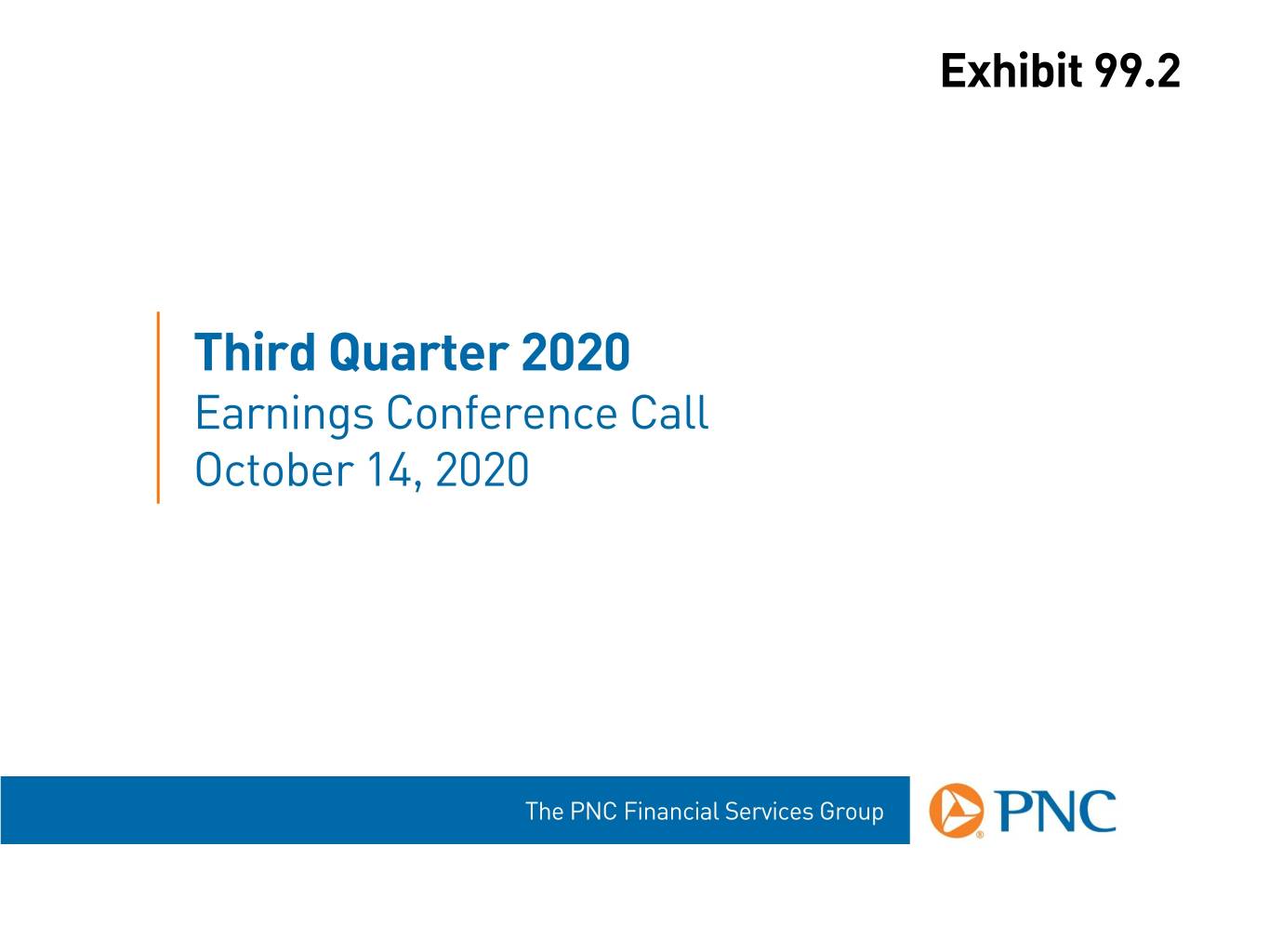
Exhibit 99.2 Third Quarter 2020 Earnings Conference Call October 14, 2020 The PNC Financial Services Group
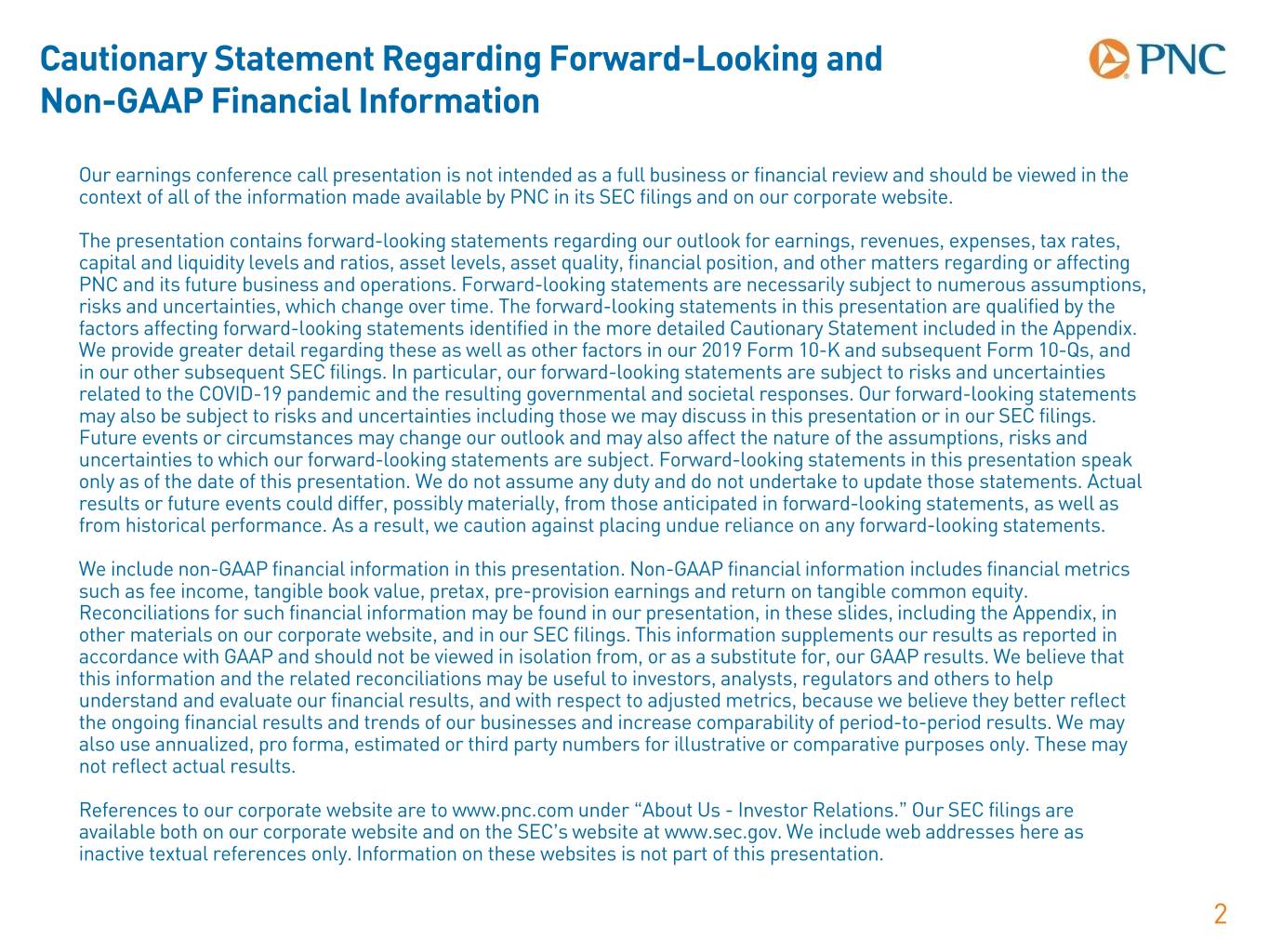
Cautionary Statement Regarding Forward-Looking and Non-GAAP Financial Information Our earnings conference call presentation is not intended as a full business or financial review and should be viewed in the context of all of the information made available by PNC in its SEC filings and on our corporate website. The presentation contains forward-looking statements regarding our outlook for earnings, revenues, expenses, tax rates, capital and liquidity levels and ratios, asset levels, asset quality, financial position, and other matters regarding or affecting PNC and its future business and operations. Forward-looking statements are necessarily subject to numerous assumptions, risks and uncertainties, which change over time. The forward-looking statements in this presentation are qualified by the factors affecting forward-looking statements identified in the more detailed Cautionary Statement included in the Appendix. We provide greater detail regarding these as well as other factors in our 2019 Form 10-K and subsequent Form 10-Qs, and in our other subsequent SEC filings. In particular, our forward-looking statements are subject to risks and uncertainties related to the COVID-19 pandemic and the resulting governmental and societal responses. Our forward-looking statements may also be subject to risks and uncertainties including those we may discuss in this presentation or in our SEC filings. Future events or circumstances may change our outlook and may also affect the nature of the assumptions, risks and uncertainties to which our forward-looking statements are subject. Forward-looking statements in this presentation speak only as of the date of this presentation. We do not assume any duty and do not undertake to update those statements. Actual results or future events could differ, possibly materially, from those anticipated in forward-looking statements, as well as from historical performance. As a result, we caution against placing undue reliance on any forward-looking statements. We include non-GAAP financial information in this presentation. Non-GAAP financial information includes financial metrics such as fee income, tangible book value, pretax, pre-provision earnings and return on tangible common equity. Reconciliations for such financial information may be found in our presentation, in these slides, including the Appendix, in other materials on our corporate website, and in our SEC filings. This information supplements our results as reported in accordance with GAAP and should not be viewed in isolation from, or as a substitute for, our GAAP results. We believe that this information and the related reconciliations may be useful to investors, analysts, regulators and others to help understand and evaluate our financial results, and with respect to adjusted metrics, because we believe they better reflect the ongoing financial results and trends of our businesses and increase comparability of period-to-period results. We may also use annualized, pro forma, estimated or third party numbers for illustrative or comparative purposes only. These may not reflect actual results. References to our corporate website are to www.pnc.com under “About Us - Investor Relations.” Our SEC filings are available both on our corporate website and on the SEC’s website at www.sec.gov. We include web addresses here as inactive textual references only. Information on these websites is not part of this presentation. 2
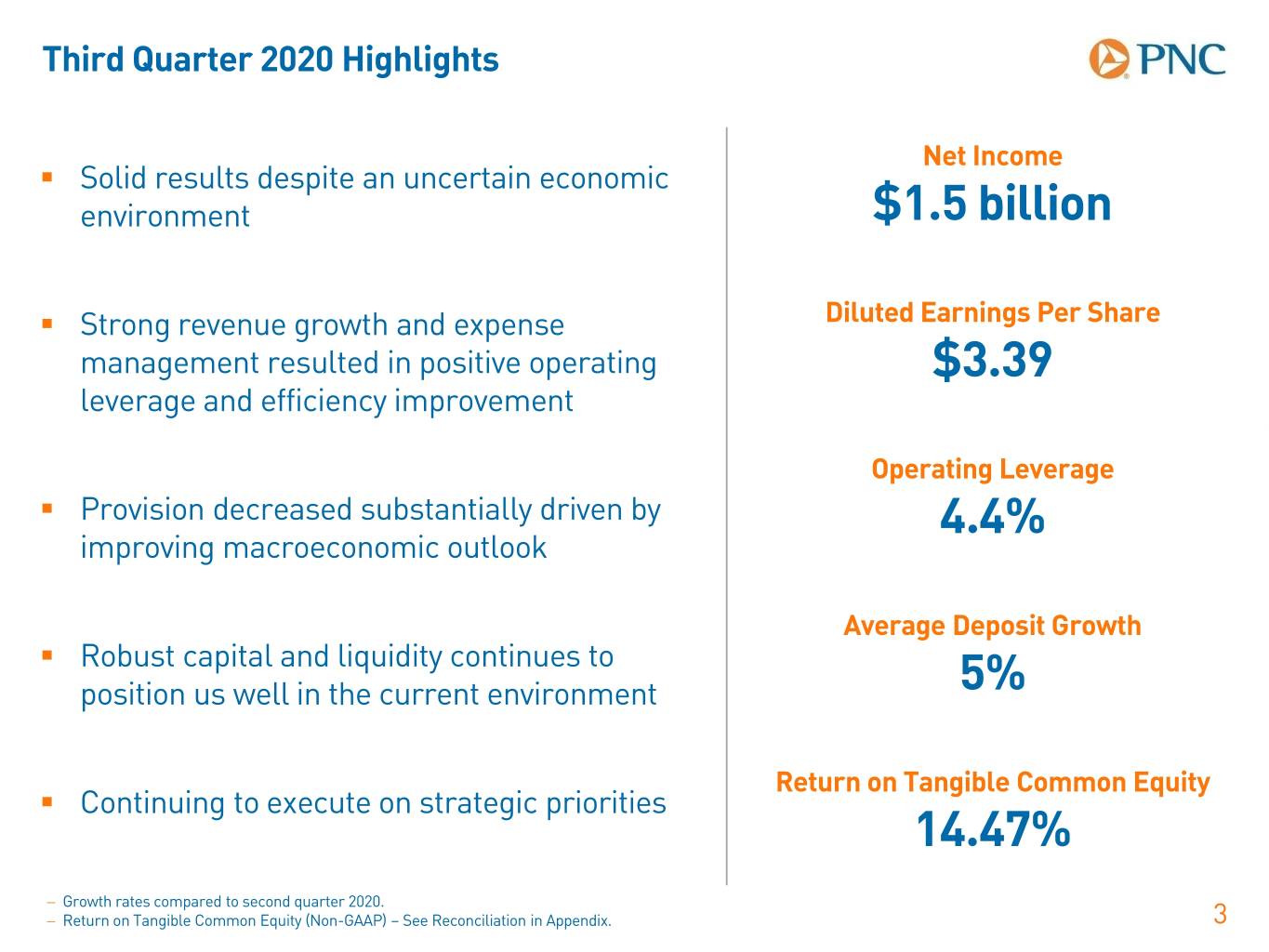
Third Quarter 2020 Highlights Net Income . Solid results despite an uncertain economic environment $1.5 billion . Strong revenue growth and expense Diluted Earnings Per Share management resulted in positive operating $3.39 leverage and efficiency improvement Operating Leverage . Provision decreased substantially driven by 4.4% improving macroeconomic outlook Average Deposit Growth . Robust capital and liquidity continues to position us well in the current environment 5% Return on Tangible Common Equity . Continuing to execute on strategic priorities 14.47% − Growth rates compared to second quarter 2020. − Return on Tangible Common Equity (Non-GAAP) – See Reconciliation in Appendix. 3
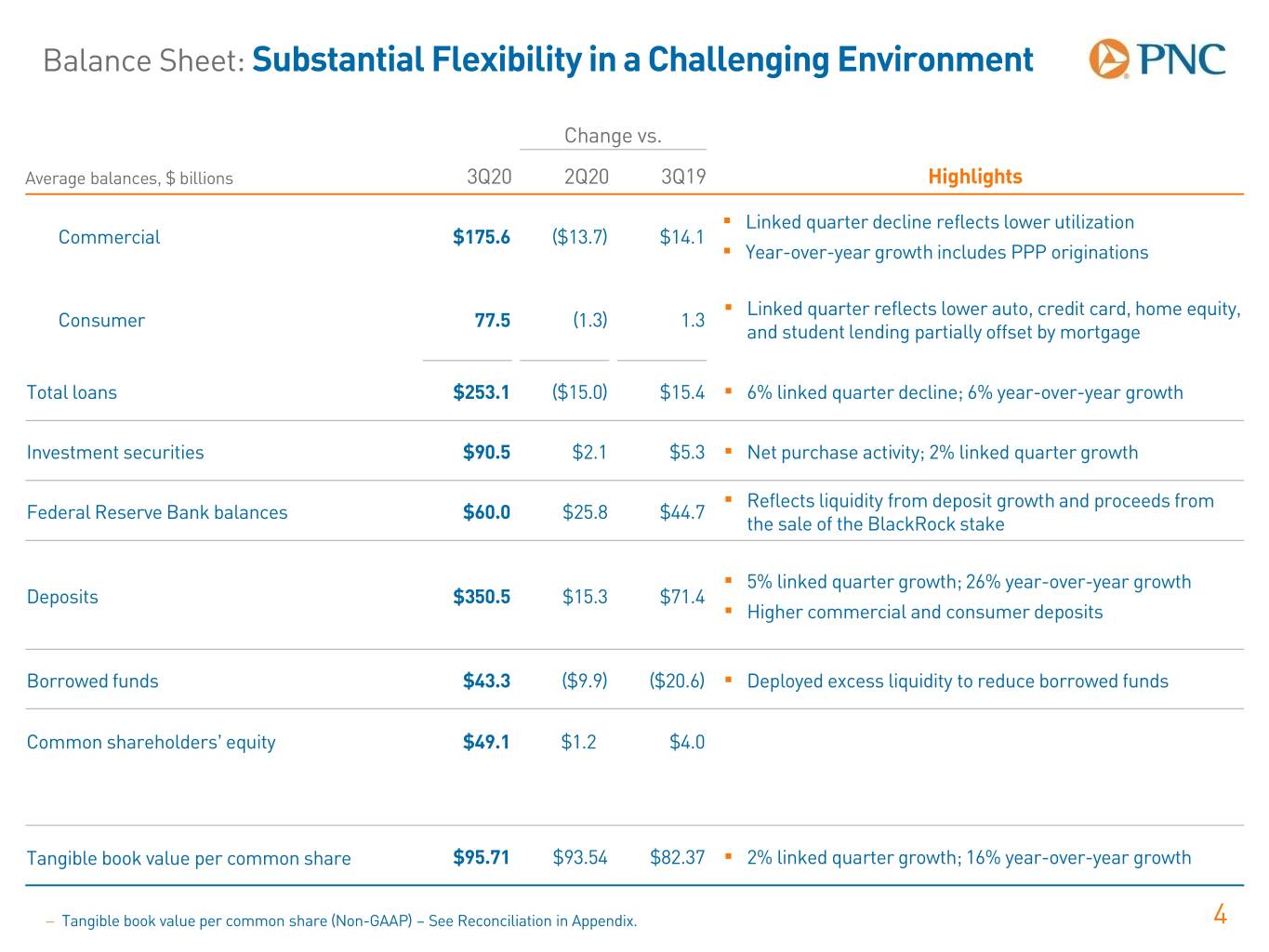
Balance Sheet: Substantial Flexibility in a Challenging Environment Change vs. Average balances, $ billions 3Q20 2Q20 3Q19 Highlights . Linked quarter decline reflects lower utilization Commercial $175.6 ($13.7) $14.1 . Year-over-year growth includes PPP originations . Linked quarter reflects lower auto, credit card, home equity, Consumer 77.5 (1.3) 1.3 and student lending partially offset by mortgage Total loans $253.1 ($15.0) $15.4 . 6% linked quarter decline; 6% year-over-year growth Investment securities $90.5 $2.1 $5.3 . Net purchase activity; 2% linked quarter growth . Reflects liquidity from deposit growth and proceeds from Federal Reserve Bank balances $60.0 $25.8 $44.7 the sale of the BlackRock stake . 5% linked quarter growth; 26% year-over-year growth Deposits $350.5 $15.3 $71.4 . Higher commercial and consumer deposits Borrowed funds $43.3 ($9.9) ($20.6) . Deployed excess liquidity to reduce borrowed funds Common shareholders’ equity $49.1 $1.2 $4.0 Tangible book value per common share $95.71 $93.54 $82.37 . 2% linked quarter growth; 16% year-over-year growth − Tangible book value per common share (Non-GAAP) – See Reconciliation in Appendix. 4
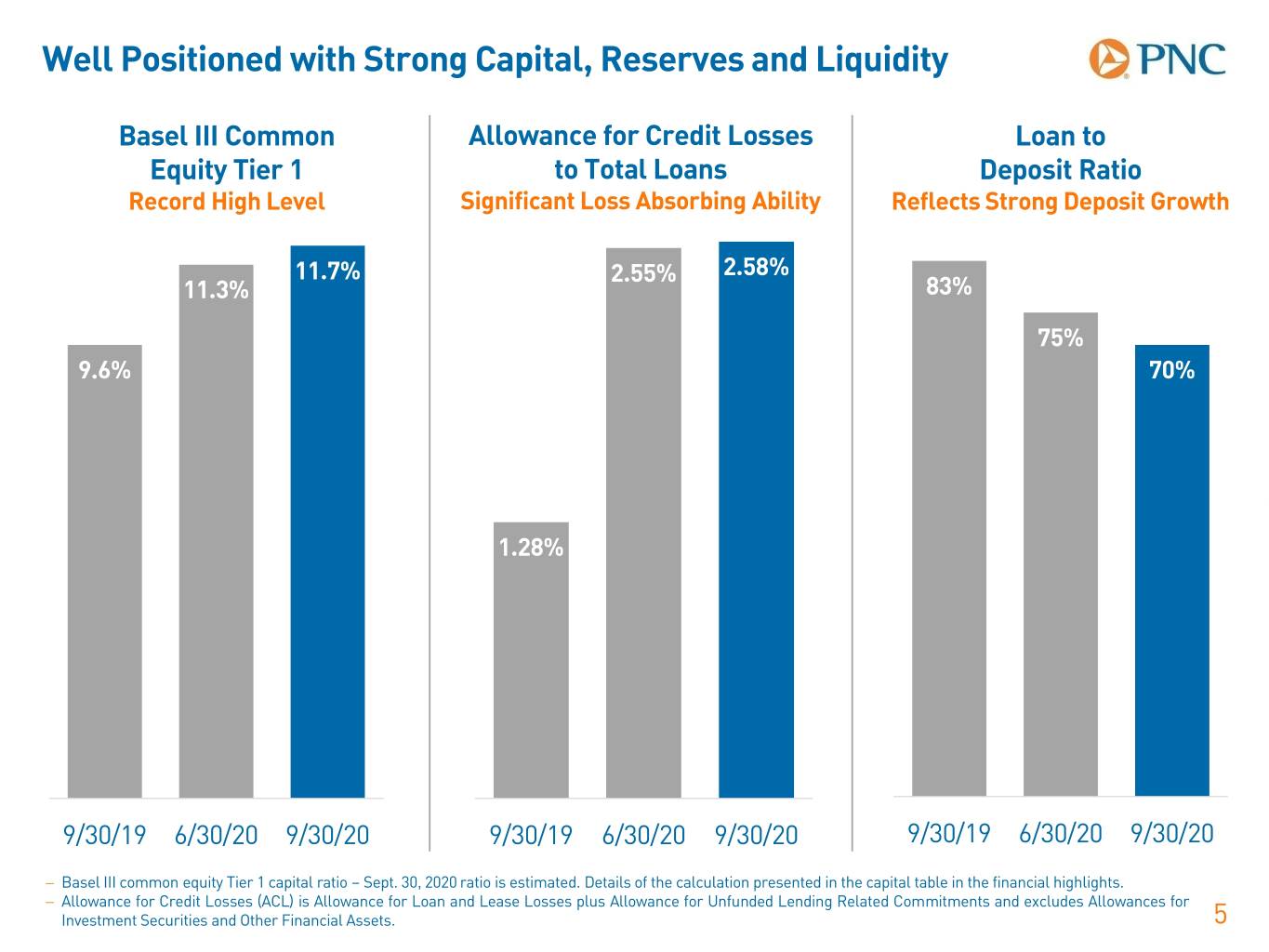
Well Positioned with Strong Capital, Reserves and Liquidity Basel III Common Allowance for Credit Losses Loan to Equity Tier 1 to Total Loans Deposit Ratio Record High Level Significant Loss Absorbing Ability Reflects Strong Deposit Growth 11.7% 2.55% 2.58% 11.3% 83% 75% 9.6% 70% 1.28% 9/30/19 6/30/20 9/30/20 9/30/19 6/30/20 9/30/20 9/30/19 6/30/20 9/30/20 − Basel III common equity Tier 1 capital ratio – Sept. 30, 2020 ratio is estimated. Details of the calculation presented in the capital table in the financial highlights. − Allowance for Credit Losses (ACL) is Allowance for Loan and Lease Losses plus Allowance for Unfunded Lending Related Commitments and excludes Allowances for Investment Securities and Other Financial Assets. 5

Balance Sheet: High Quality Loans Funded with Low Cost Deposits Loans Deposits 6% Year-over-Year Growth 26% Year-over-Year Growth $268.1 $350.5 $335.2 $253.1 $189.3 $248.6 $237.7 $241.4 $175.6 $161.5 $279.1 $207.0 4.47% 1.02% Average balances, $ billions Average balances, $ billions 0.23% 3.37% 3.32% 0.12% $101.9 $76.2 $78.8 $77.5 $93.8 $72.1 3Q19 2Q20 3Q20 3Q19 2Q20 3Q20 Consumer Commercial Total Loan Yield Noninterest-bearing Interest-bearing Deposit Rate 6
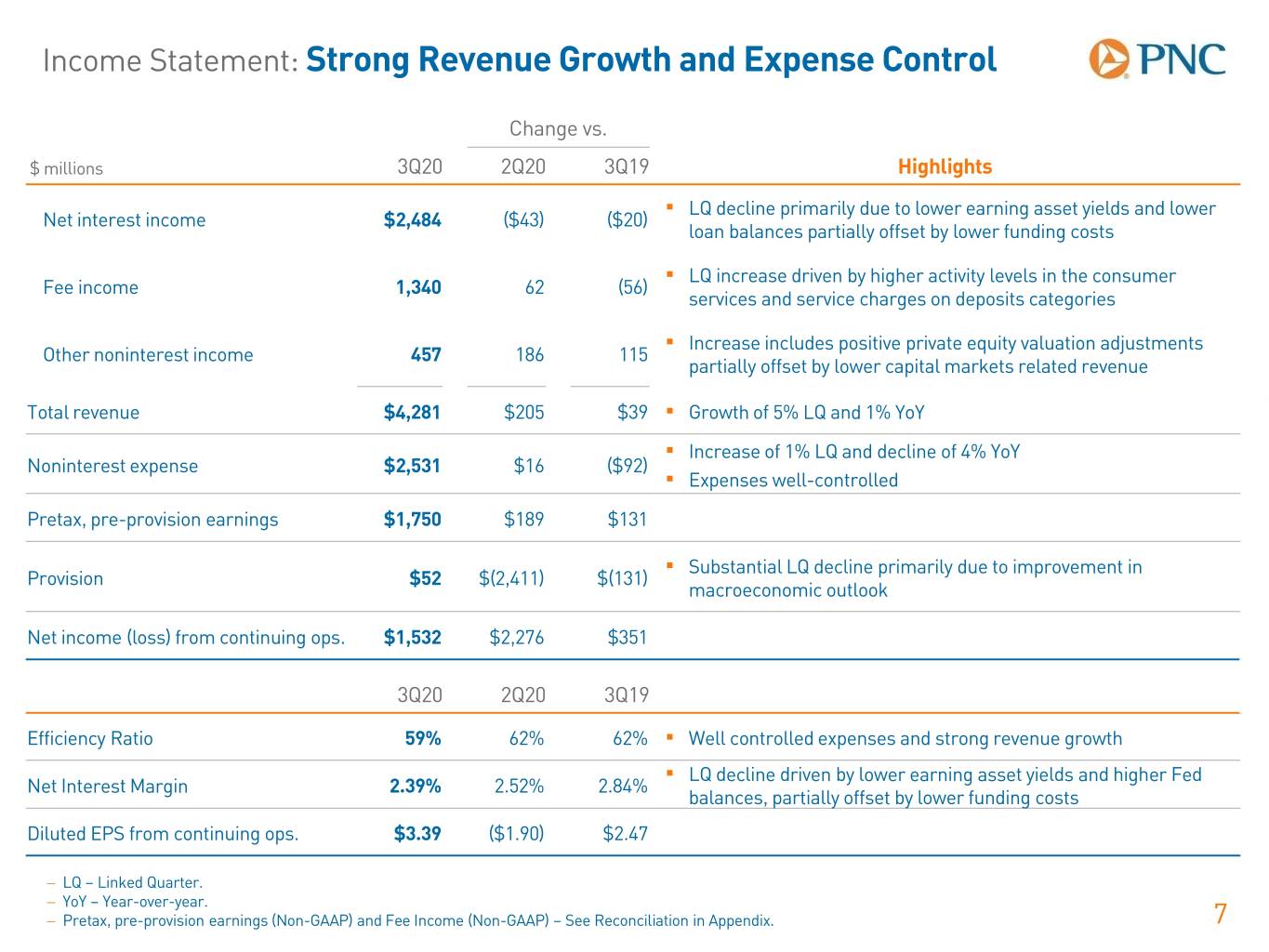
Income Statement: Strong Revenue Growth and Expense Control Change vs. $ millions 3Q20 2Q20 3Q19 Highlights . LQ decline primarily due to lower earning asset yields and lower Net interest income $2,484 ($43) ($20) loan balances partially offset by lower funding costs . LQ increase driven by higher activity levels in the consumer Fee income 1,340 62 (56) services and service charges on deposits categories . Increase includes positive private equity valuation adjustments Other noninterest income 457 186 115 partially offset by lower capital markets related revenue Total revenue $4,281 $205 $39 . Growth of 5% LQ and 1% YoY . Increase of 1% LQ and decline of 4% YoY Noninterest expense $2,531 $16 ($92) . Expenses well-controlled Pretax, pre-provision earnings $1,750 $189 $131 . Substantial LQ decline primarily due to improvement in Provision $52 $(2,411) $(131) macroeconomic outlook Net income (loss) from continuing ops. $1,532 $2,276 $351 3Q20 2Q20 3Q19 Efficiency Ratio 59% 62% 62% . Well controlled expenses and strong revenue growth . LQ decline driven by lower earning asset yields and higher Fed Net Interest Margin 2.39% 2.52% 2.84% balances, partially offset by lower funding costs Diluted EPS from continuing ops. $3.39 ($1.90) $2.47 − LQ – Linked Quarter. − YoY – Year-over-year. − Pretax, pre-provision earnings (Non-GAAP) and Fee Income (Non-GAAP) – See Reconciliation in Appendix. 7

Income Statement: Generating Positive Operating Leverage Managing Expenses in a Difficult Revenue Environment 3Q20 versus 3Q19 YTD ‘20 versus YTD ‘19 Revenue Growth +0.9% +1.4% Net Interest Income (0.8)% +0.6% Noninterest Income +3.4% +2.6% Expense Decline (3.5)% (2.9)% Operating Leverage +4.4% +4.3% − YTD – Year-to-date through 9/30. 8

Credit: COVID-19 High Impact Industries $18.3 billion Outstanding Loan Balances ($16.4 billion excluding PPP Loans) $10.5 billion Commercial & Industrial Loans ($8.6 billion excluding PPP Loans) $4.8 billion / 67% Utilization Leisure Recreation: Restaurants, casinos, hotels, convention centers Includes $0.7 billion in PPP Loans $1.4 billion / 30% Utilization Retail (non-essential): Retail excluding auto, gas, staples Includes $0.2 billion in PPP Loans $1.8 billion / 83% Utilization Healthcare Facilities: Elective, private practices Includes $0.4 billion in PPP Loans $0.9 billion / 80% Utilization Consumer Services: Religious organizations, childcare Includes $0.4 billion in PPP Loans $0.8 billion / 74% Utilization Leisure Travel: Cruise, airlines, other travel / transportation Includes $0.1 billion in PPP Loans $0.8 billion / 46% Utilization Other Impacted Areas: Shipping, senior living, specialty education Includes $0.1 billion in PPP Loans $7.8 billion Commercial Real Estate and Related Loans Non-Essential Retail & Restaurants: Malls, lifestyle centers, outlets, restaurants $3.2 billion / 69% Utilization Hotel: Full service, limited service, extended stay $3.0 billion / 87% Utilization Seniors Housing: Assisted living, independent living $1.6 billion / 58% Utilization − PPP Lending within the Commercial Real Estate and Related Loans category is not material. − Balances as of 9/30/20; excludes securitizations. − Commercial & Industrial loans exclude PNC Real Estate business loans. Commercial real estate and related loans include commercial loans in the PNC Real 9 Estate business.
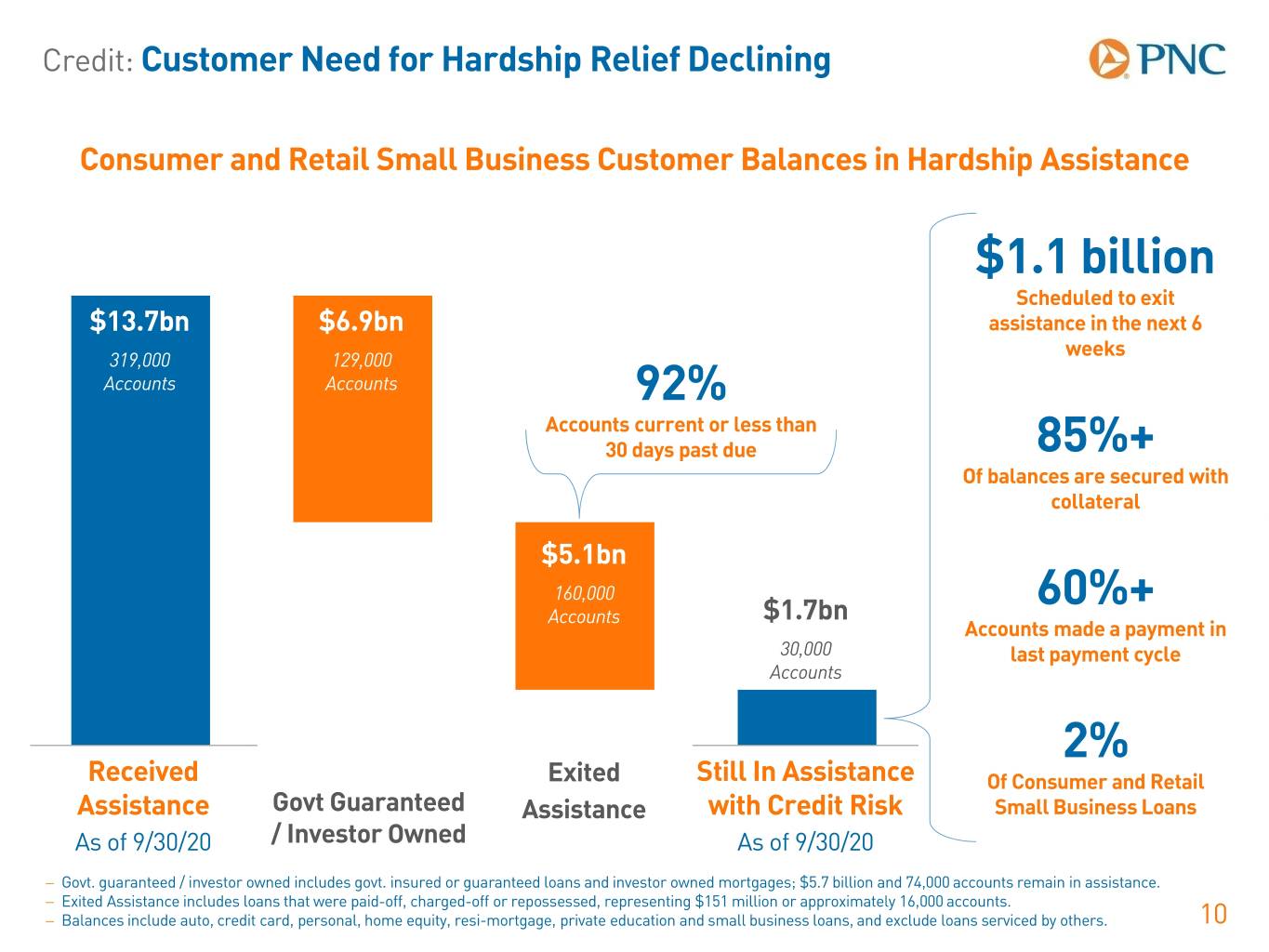
Credit: Customer Need for Hardship Relief Declining Consumer and Retail Small Business Customer Balances in Hardship Assistance $1.1 billion Scheduled to exit $13.7bn $6.9bn assistance in the next 6 weeks 319,000 129,000 Accounts Accounts 92% Accounts current or less than 30 days past due 85%+ Of balances are secured with collateral $5.1bn 160,000 60%+ Accounts $1.7bn Accounts made a payment in 30,000 last payment cycle Accounts Catego ry 1 Catego ry 2 Catego ry 3 Catego ry 4 2% Received Exited Still In Assistance Of Consumer and Retail Assistance Govt Guaranteed Assistance with Credit Risk Small Business Loans As of 9/30/20 / Investor Owned As of 9/30/20 − Govt. guaranteed / investor owned includes govt. insured or guaranteed loans and investor owned mortgages; $5.7 billion and 74,000 accounts remain in assistance. − Exited Assistance includes loans that were paid-off, charged-off or repossessed, representing $151 million or approximately 16,000 accounts. − Balances include auto, credit card, personal, home equity, resi-mortgage, private education and small business loans, and exclude loans serviced by others. 10
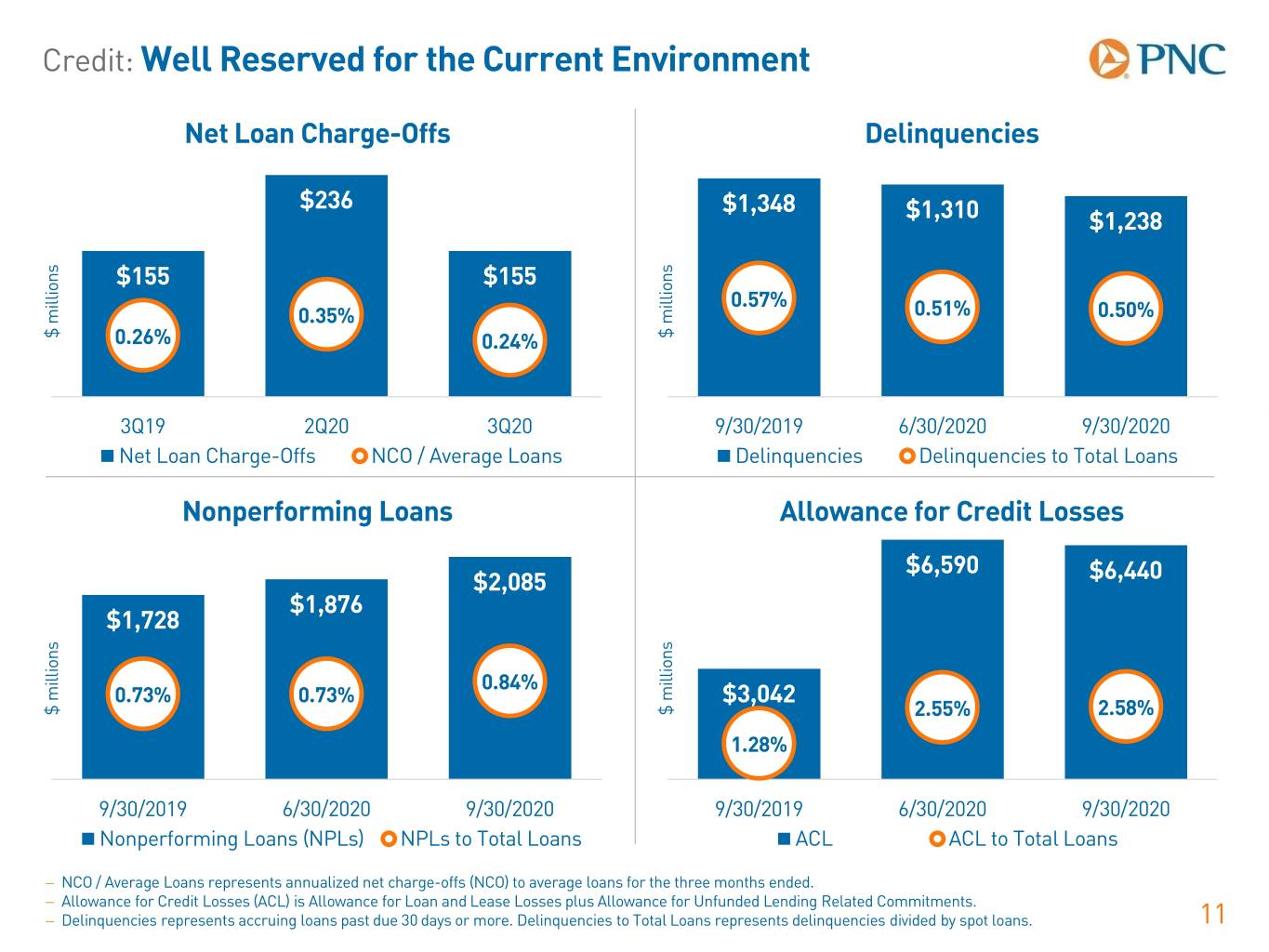
Credit: Well Reserved for the Current Environment Net Loan Charge-Offs Delinquencies 250 0.01 0.015 1400 0.013 1200 200 $236 0.008 $1,348 $1,310 $1,238 0.011 1000 0.009 150 0.006 800 $155 $155 0.007 600 100 0.004 0.57% 0.005 0.35% 0.51% 0.50% 400 $ millions 0.26% $ millions 0.003 50 0.24% 0.002 200 0.001 0 0 0 -0.001 3Q19 2Q20 3Q20 9/30/2019 6/30/2020 9/30/2020 Net Loan Charge-Offs NCO / Average Loans Delinquencies Delinquencies to Total Loans Nonperforming Loans Allowance for Credit Losses 0.02 0.08 6000 2000 $6,590 $2,085 $6,440 0.07 5000 0.015 $1,876 0.06 1500 $1,728 4000 0.05 0.01 0.04 3000 1000 0.84% 0.73% 0.73% $3,042 0.03 2000 $ millions $ millions 2.55% 2.58% 0.005 0.02 500 1000 1.28% 0.01 0 0 0 0 9/30/2019 6/30/2020 9/30/2020 9/30/2019 6/30/2020 9/30/2020 Nonperforming Loans (NPLs) NPLs to Total Loans ACL ACL to Total Loans − NCO / Average Loans represents annualized net charge-offs (NCO) to average loans for the three months ended. − Allowance for Credit Losses (ACL) is Allowance for Loan and Lease Losses plus Allowance for Unfunded Lending Related Commitments. − Delinquencies represents accruing loans past due 30 days or more. Delinquencies to Total Loans represents delinquencies divided by spot loans. 11
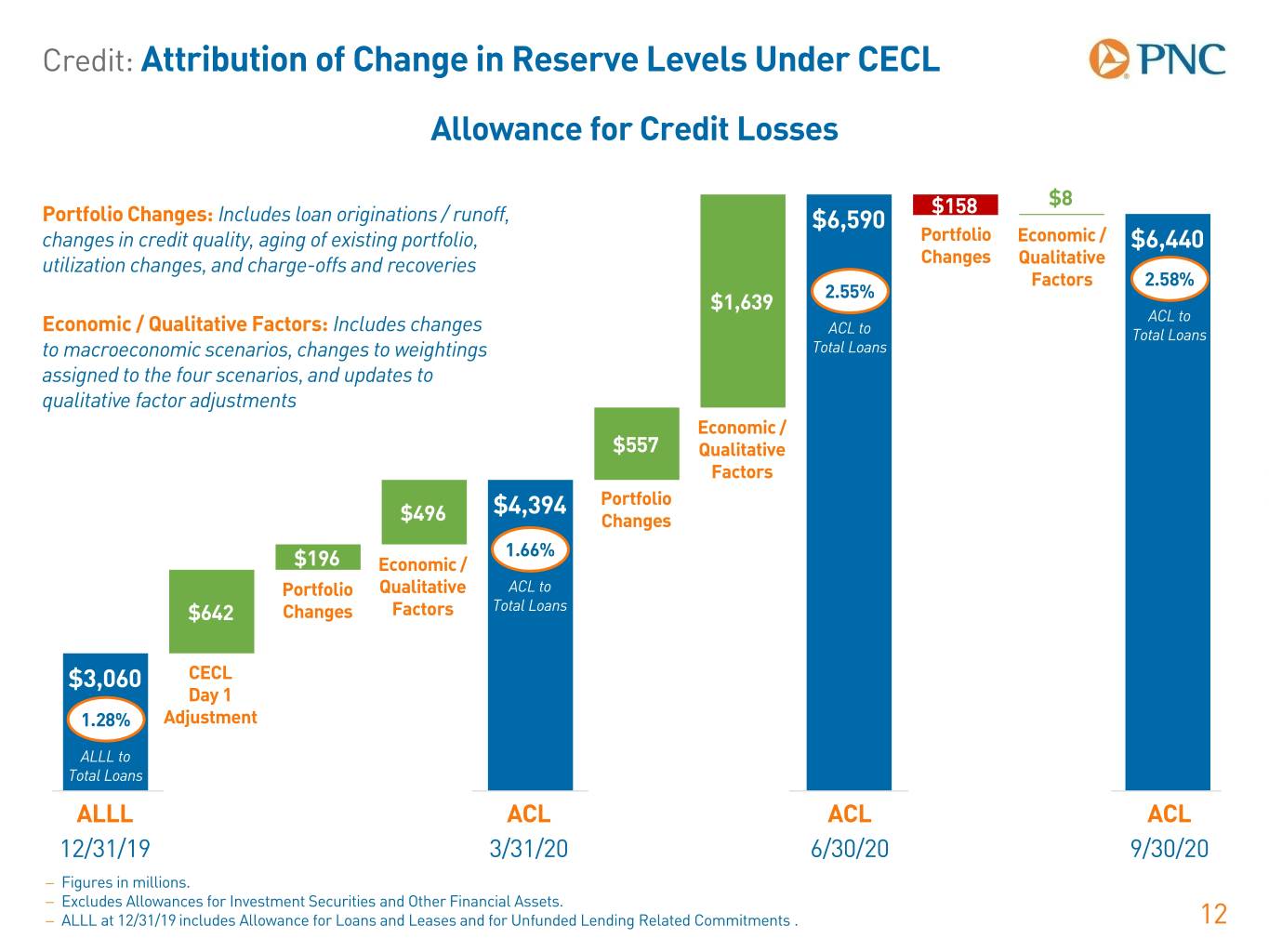
Credit: Attribution of Change in Reserve Levels Under CECL Allowance for Credit Losses $158 $8 Portfolio Changes: Includes loan originations / runoff, $6,590 changes in credit quality, aging of existing portfolio, Portfolio Economic / $6,440 utilization changes, and charge-offs and recoveries Changes Qualitative Factors 2.58% 2.55% $1,639 Economic / Qualitative Factors: ACL to Includes changes ACL to Total Loans to macroeconomic scenarios, changes to weightings Total Loans assigned to the four scenarios, and updates to qualitative factor adjustments Economic / $557 Qualitative Factors $4,394 Portfolio $496 Changes 1.66% $196 Economic / Portfolio Qualitative ACL to $642 Changes Factors Total Loans $3,060 CECL Day 1 1.28% Adjustment ALLL to Total Loans 1 2 3 4 5 6 7 8 9 10 11 ALLL ACL ACL ACL 12/31/19 3/31/20 6/30/20 9/30/20 − Figures in millions. − Excludes Allowances for Investment Securities and Other Financial Assets. − ALLL at 12/31/19 includes Allowance for Loans and Leases and for Unfunded Lending Related Commitments . 12
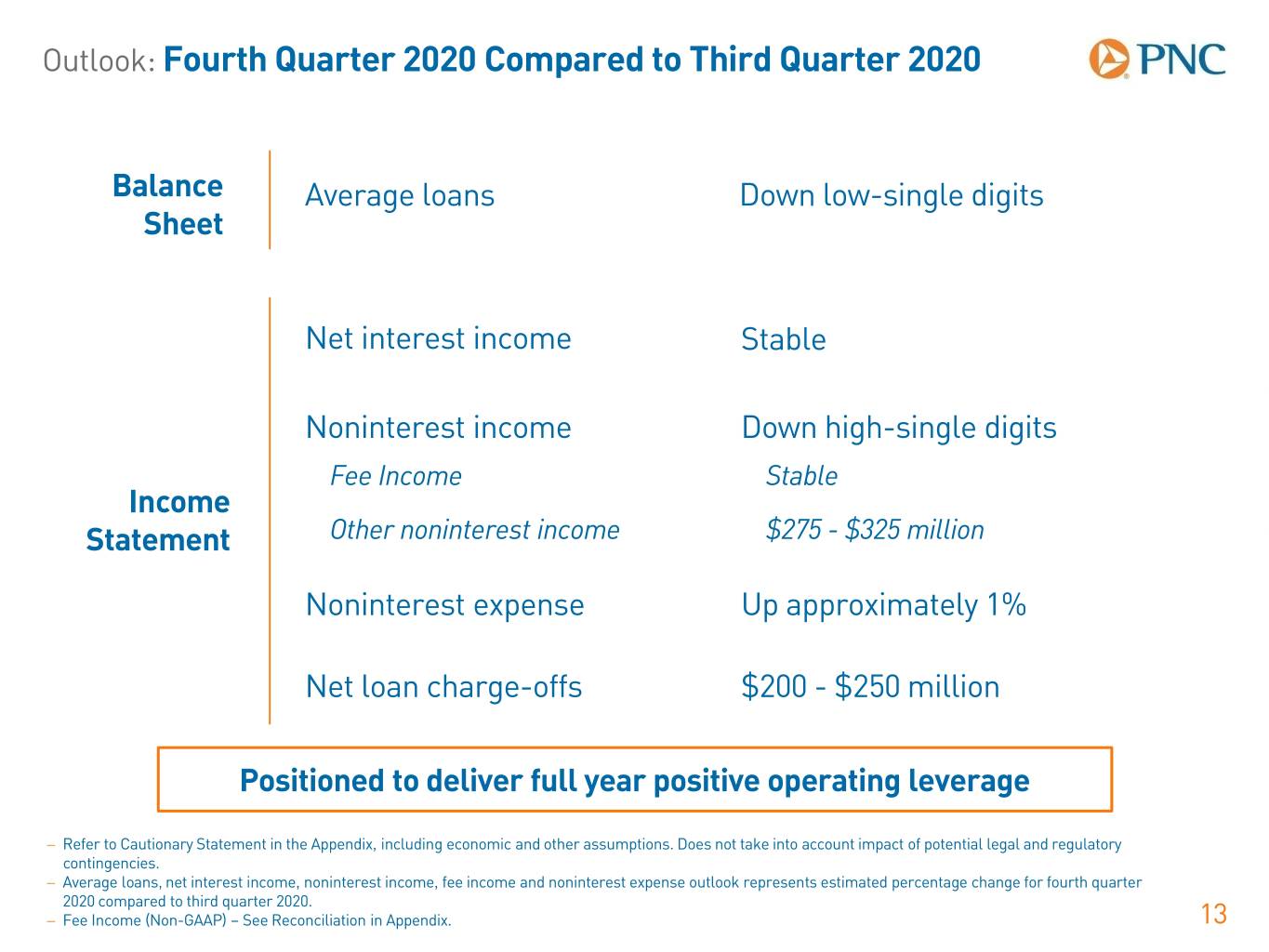
Outlook: Fourth Quarter 2020 Compared to Third Quarter 2020 Balance Average loans Down low-single digits Sheet Net interest income Stable Noninterest income Down high-single digits Fee Income Stable Income Statement Other noninterest income $275 - $325 million Noninterest expense Up approximately 1% Net loan charge-offs $200 - $250 million Positioned to deliver full year positive operating leverage − Refer to Cautionary Statement in the Appendix, including economic and other assumptions. Does not take into account impact of potential legal and regulatory contingencies. − Average loans, net interest income, noninterest income, fee income and noninterest expense outlook represents estimated percentage change for fourth quarter 2020 compared to third quarter 2020. − Fee Income (Non-GAAP) – See Reconciliation in Appendix. 13
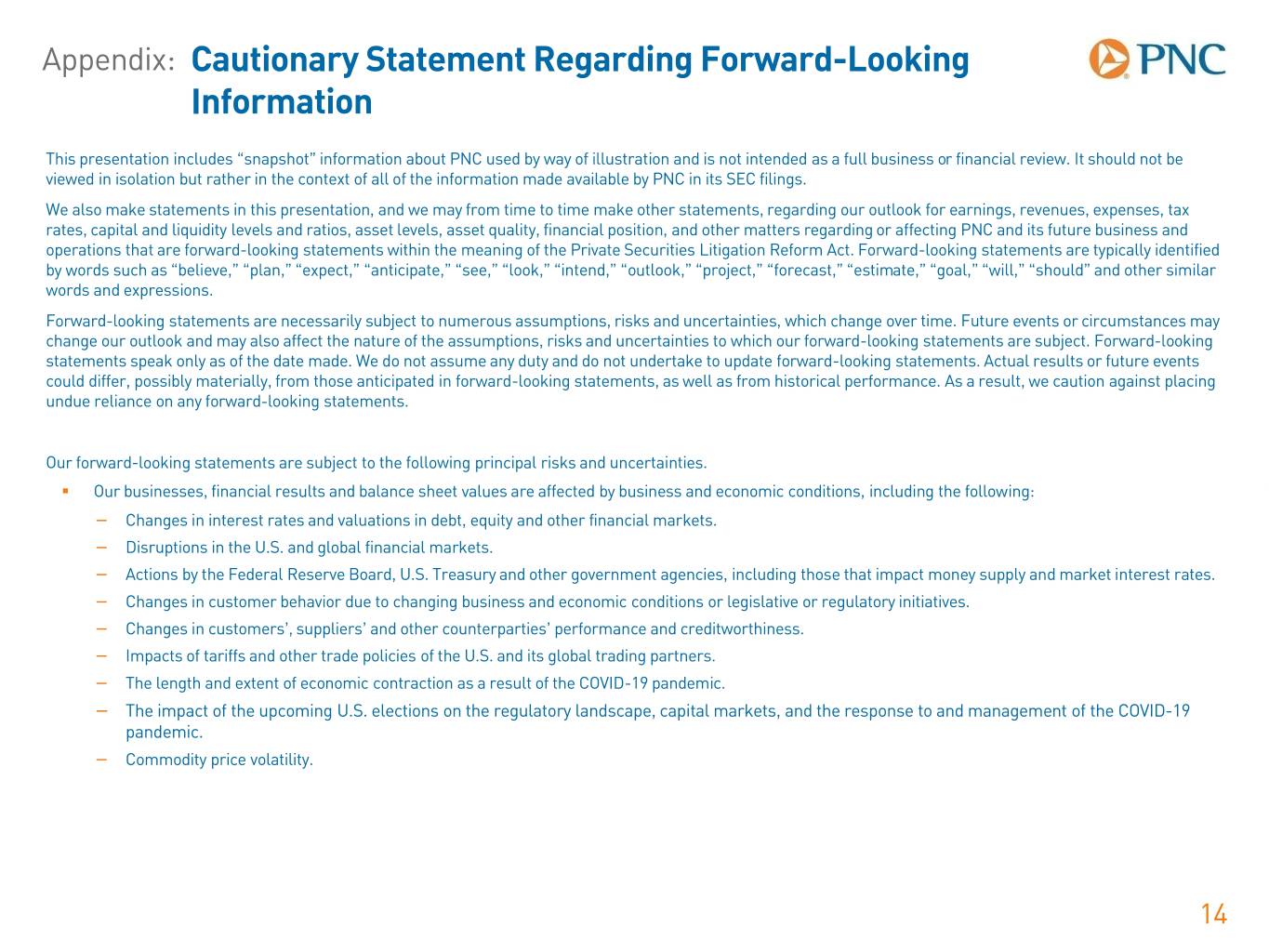
Appendix: Cautionary Statement Regarding Forward-Looking Information This presentation includes “snapshot” information about PNC used by way of illustration and is not intended as a full business or financial review. It should not be viewed in isolation but rather in the context of all of the information made available by PNC in its SEC filings. We also make statements in this presentation, and we may from time to time make other statements, regarding our outlook for earnings, revenues, expenses, tax rates, capital and liquidity levels and ratios, asset levels, asset quality, financial position, and other matters regarding or affecting PNC and its future business and operations that are forward-looking statements within the meaning of the Private Securities Litigation Reform Act. Forward-looking statements are typically identified by words such as “believe,” “plan,” “expect,” “anticipate,” “see,” “look,” “intend,” “outlook,” “project,” “forecast,” “estimate,” “goal,” “will,” “should” and other similar words and expressions. Forward-looking statements are necessarily subject to numerous assumptions, risks and uncertainties, which change over time. Future events or circumstances may change our outlook and may also affect the nature of the assumptions, risks and uncertainties to which our forward-looking statements are subject. Forward-looking statements speak only as of the date made. We do not assume any duty and do not undertake to update forward-looking statements. Actual results or future events could differ, possibly materially, from those anticipated in forward-looking statements, as well as from historical performance. As a result, we caution against placing undue reliance on any forward-looking statements. Our forward-looking statements are subject to the following principal risks and uncertainties. . Our businesses, financial results and balance sheet values are affected by business and economic conditions, including the following: − Changes in interest rates and valuations in debt, equity and other financial markets. − Disruptions in the U.S. and global financial markets. − Actions by the Federal Reserve Board, U.S. Treasury and other government agencies, including those that impact money supply and market interest rates. − Changes in customer behavior due to changing business and economic conditions or legislative or regulatory initiatives. − Changes in customers’, suppliers’ and other counterparties’ performance and creditworthiness. − Impacts of tariffs and other trade policies of the U.S. and its global trading partners. − The length and extent of economic contraction as a result of the COVID-19 pandemic. − The impact of the upcoming U.S. elections on the regulatory landscape, capital markets, and the response to and management of the COVID-19 pandemic. − Commodity price volatility. 14
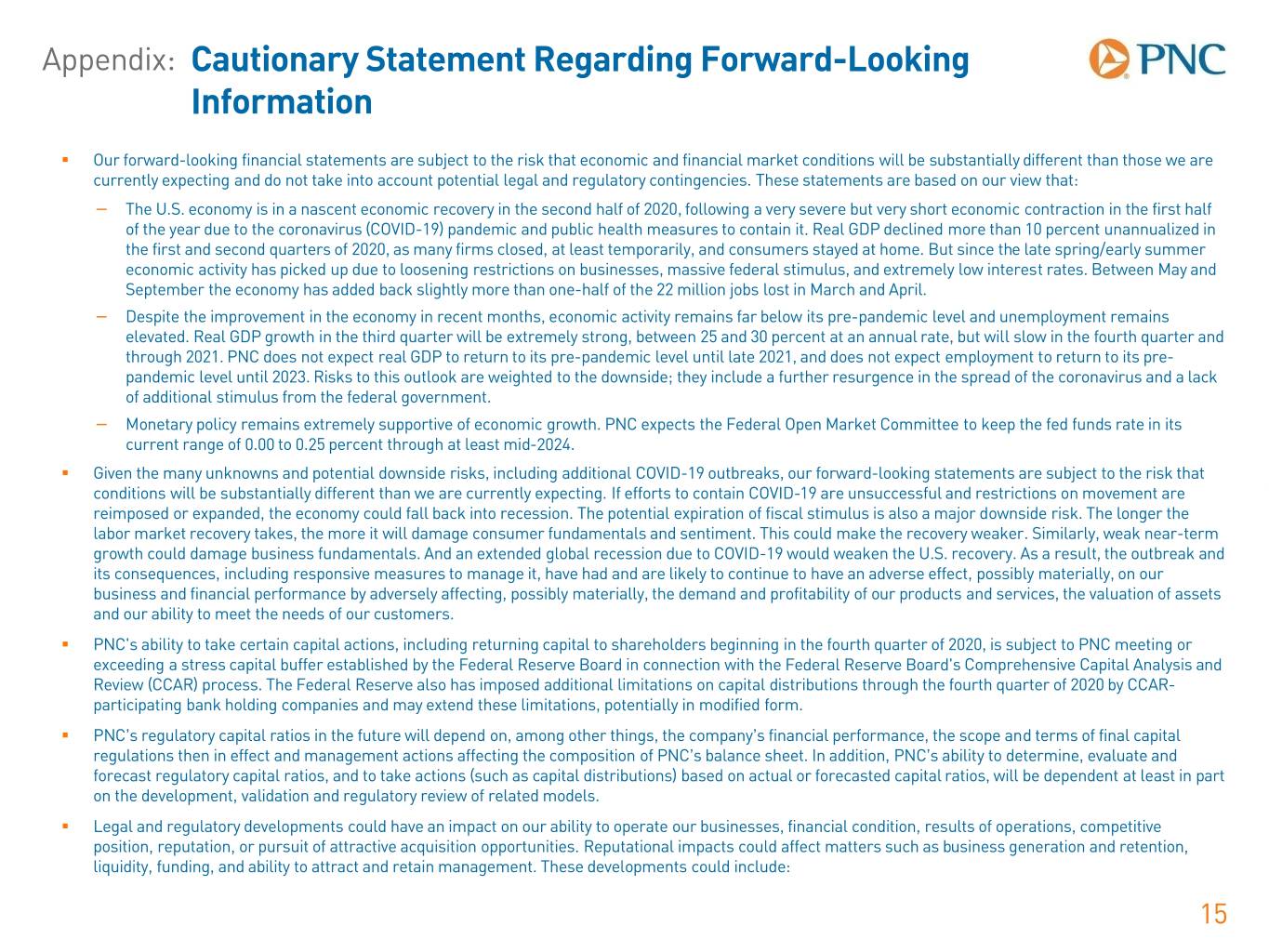
Appendix: Cautionary Statement Regarding Forward-Looking Information . Our forward-looking financial statements are subject to the risk that economic and financial market conditions will be substantially different than those we are currently expecting and do not take into account potential legal and regulatory contingencies. These statements are based on our view that: − The U.S. economy is in a nascent economic recovery in the second half of 2020, following a very severe but very short economic contraction in the first half of the year due to the coronavirus (COVID-19) pandemic and public health measures to contain it. Real GDP declined more than 10 percent unannualized in the first and second quarters of 2020, as many firms closed, at least temporarily, and consumers stayed at home. But since the late spring/early summer economic activity has picked up due to loosening restrictions on businesses, massive federal stimulus, and extremely low interest rates. Between May and September the economy has added back slightly more than one-half of the 22 million jobs lost in March and April. − Despite the improvement in the economy in recent months, economic activity remains far below its pre-pandemic level and unemployment remains elevated. Real GDP growth in the third quarter will be extremely strong, between 25 and 30 percent at an annual rate, but will slow in the fourth quarter and through 2021. PNC does not expect real GDP to return to its pre-pandemic level until late 2021, and does not expect employment to return to its pre- pandemic level until 2023. Risks to this outlook are weighted to the downside; they include a further resurgence in the spread of the coronavirus and a lack of additional stimulus from the federal government. − Monetary policy remains extremely supportive of economic growth. PNC expects the Federal Open Market Committee to keep the fed funds rate in its current range of 0.00 to 0.25 percent through at least mid-2024. . Given the many unknowns and potential downside risks, including additional COVID-19 outbreaks, our forward-looking statements are subject to the risk that conditions will be substantially different than we are currently expecting. If efforts to contain COVID-19 are unsuccessful and restrictions on movement are reimposed or expanded, the economy could fall back into recession. The potential expiration of fiscal stimulus is also a major downside risk. The longer the labor market recovery takes, the more it will damage consumer fundamentals and sentiment. This could make the recovery weaker. Similarly, weak near-term growth could damage business fundamentals. And an extended global recession due to COVID-19 would weaken the U.S. recovery. As a result, the outbreak and its consequences, including responsive measures to manage it, have had and are likely to continue to have an adverse effect, possibly materially, on our business and financial performance by adversely affecting, possibly materially, the demand and profitability of our products and services, the valuation of assets and our ability to meet the needs of our customers. . PNC's ability to take certain capital actions, including returning capital to shareholders beginning in the fourth quarter of 2020, is subject to PNC meeting or exceeding a stress capital buffer established by the Federal Reserve Board in connection with the Federal Reserve Board's Comprehensive Capital Analysis and Review (CCAR) process. The Federal Reserve also has imposed additional limitations on capital distributions through the fourth quarter of 2020 by CCAR- participating bank holding companies and may extend these limitations, potentially in modified form. . PNC’s regulatory capital ratios in the future will depend on, among other things, the company’s financial performance, the scope and terms of final capital regulations then in effect and management actions affecting the composition of PNC’s balance sheet. In addition, PNC’s ability to determine, evaluate and forecast regulatory capital ratios, and to take actions (such as capital distributions) based on actual or forecasted capital ratios, will be dependent at least in part on the development, validation and regulatory review of related models. . Legal and regulatory developments could have an impact on our ability to operate our businesses, financial condition, results of operations, competitive position, reputation, or pursuit of attractive acquisition opportunities. Reputational impacts could affect matters such as business generation and retention, liquidity, funding, and ability to attract and retain management. These developments could include: 15
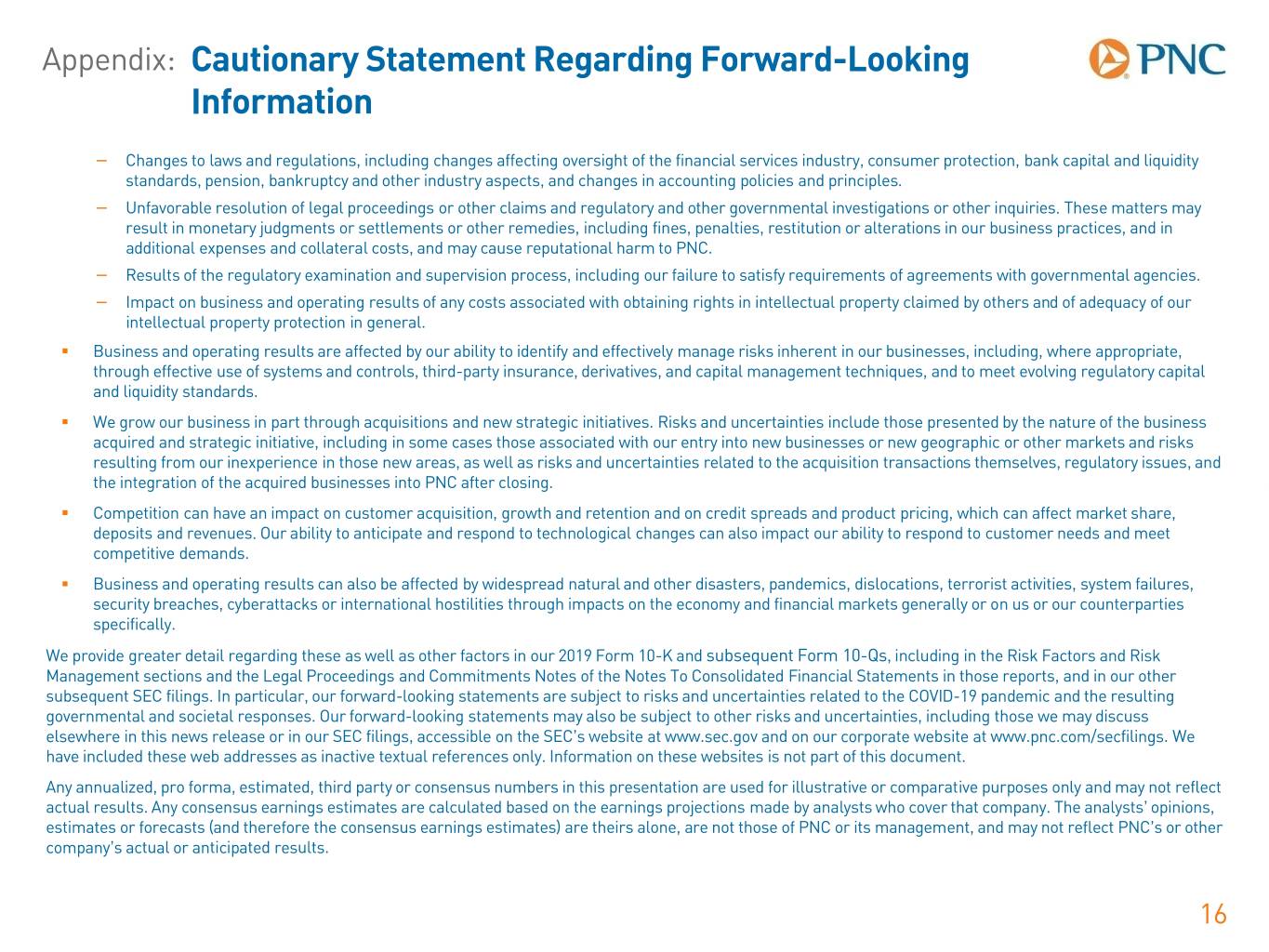
Appendix: Cautionary Statement Regarding Forward-Looking Information − Changes to laws and regulations, including changes affecting oversight of the financial services industry, consumer protection, bank capital and liquidity standards, pension, bankruptcy and other industry aspects, and changes in accounting policies and principles. − Unfavorable resolution of legal proceedings or other claims and regulatory and other governmental investigations or other inquiries. These matters may result in monetary judgments or settlements or other remedies, including fines, penalties, restitution or alterations in our business practices, and in additional expenses and collateral costs, and may cause reputational harm to PNC. − Results of the regulatory examination and supervision process, including our failure to satisfy requirements of agreements with governmental agencies. − Impact on business and operating results of any costs associated with obtaining rights in intellectual property claimed by others and of adequacy of our intellectual property protection in general. . Business and operating results are affected by our ability to identify and effectively manage risks inherent in our businesses, including, where appropriate, through effective use of systems and controls, third-party insurance, derivatives, and capital management techniques, and to meet evolving regulatory capital and liquidity standards. . We grow our business in part through acquisitions and new strategic initiatives. Risks and uncertainties include those presented by the nature of the business acquired and strategic initiative, including in some cases those associated with our entry into new businesses or new geographic or other markets and risks resulting from our inexperience in those new areas, as well as risks and uncertainties related to the acquisition transactions themselves, regulatory issues, and the integration of the acquired businesses into PNC after closing. . Competition can have an impact on customer acquisition, growth and retention and on credit spreads and product pricing, which can affect market share, deposits and revenues. Our ability to anticipate and respond to technological changes can also impact our ability to respond to customer needs and meet competitive demands. . Business and operating results can also be affected by widespread natural and other disasters, pandemics, dislocations, terrorist activities, system failures, security breaches, cyberattacks or international hostilities through impacts on the economy and financial markets generally or on us or our counterparties specifically. We provide greater detail regarding these as well as other factors in our 2019 Form 10-K and subsequent Form 10-Qs, including in the Risk Factors and Risk Management sections and the Legal Proceedings and Commitments Notes of the Notes To Consolidated Financial Statements in those reports, and in our other subsequent SEC filings. In particular, our forward-looking statements are subject to risks and uncertainties related to the COVID-19 pandemic and the resulting governmental and societal responses. Our forward-looking statements may also be subject to other risks and uncertainties, including those we may discuss elsewhere in this news release or in our SEC filings, accessible on the SEC’s website at www.sec.gov and on our corporate website at www.pnc.com/secfilings. We have included these web addresses as inactive textual references only. Information on these websites is not part of this document. Any annualized, pro forma, estimated, third party or consensus numbers in this presentation are used for illustrative or comparative purposes only and may not reflect actual results. Any consensus earnings estimates are calculated based on the earnings projections made by analysts who cover that company. The analysts’ opinions, estimates or forecasts (and therefore the consensus earnings estimates) are theirs alone, are not those of PNC or its management, and may not reflect PNC’s or other company’s actual or anticipated results. 16
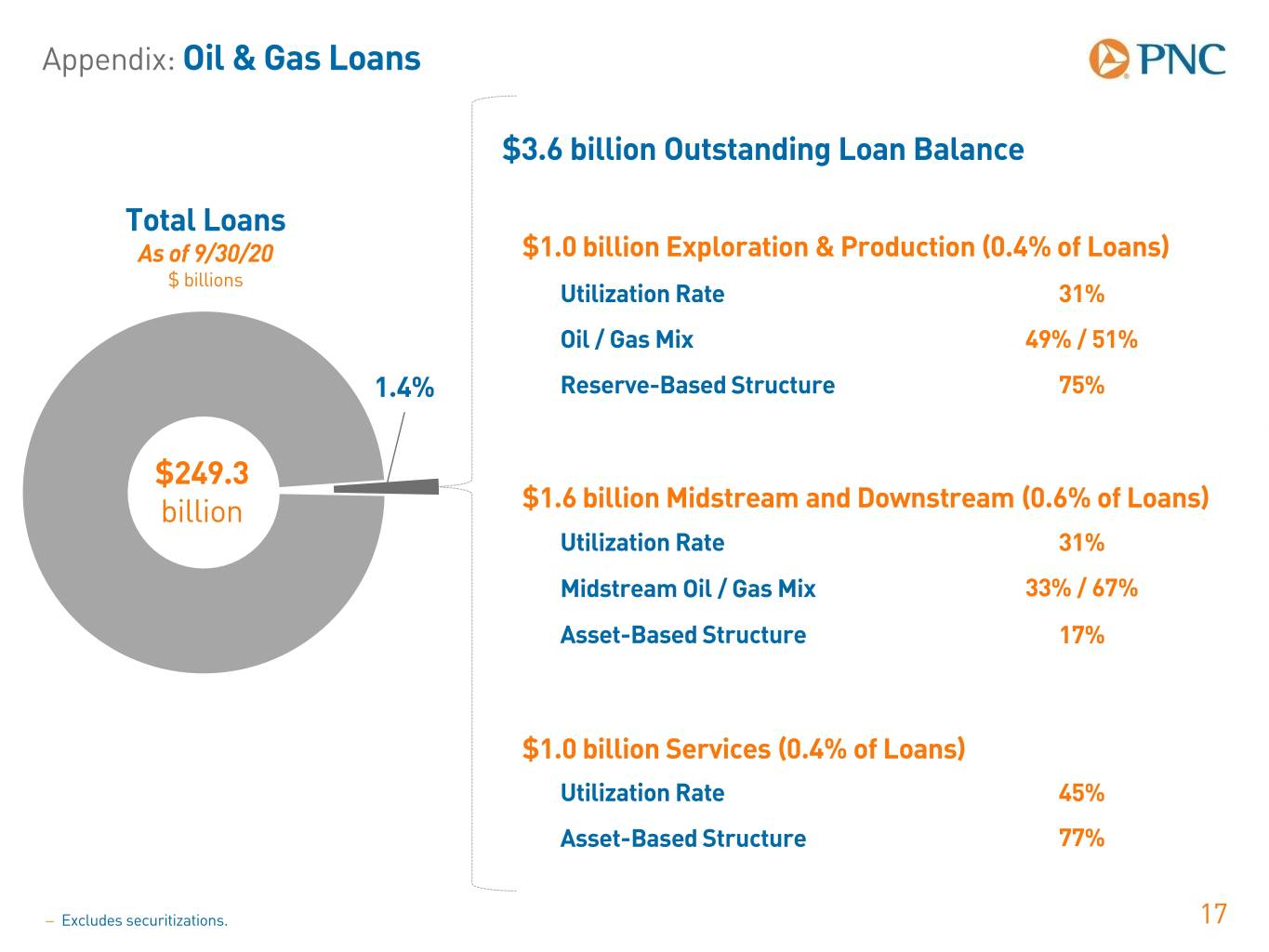
Appendix: Oil & Gas Loans $3.6 billion Outstanding Loan Balance Total Loans As of 9/30/20 $1.0 billion Exploration & Production (0.4% of Loans) $ billions Utilization Rate 31% Oil / Gas Mix 49% / 51% 1.4% Reserve-Based Structure 75% $249.3 billion $1.6 billion Midstream and Downstream (0.6% of Loans) Utilization Rate 31% Midstream Oil / Gas Mix 33% / 67% Asset-Based Structure 17% $1.0 billion Services (0.4% of Loans) Utilization Rate 45% Asset-Based Structure 77% − Excludes securitizations. 17
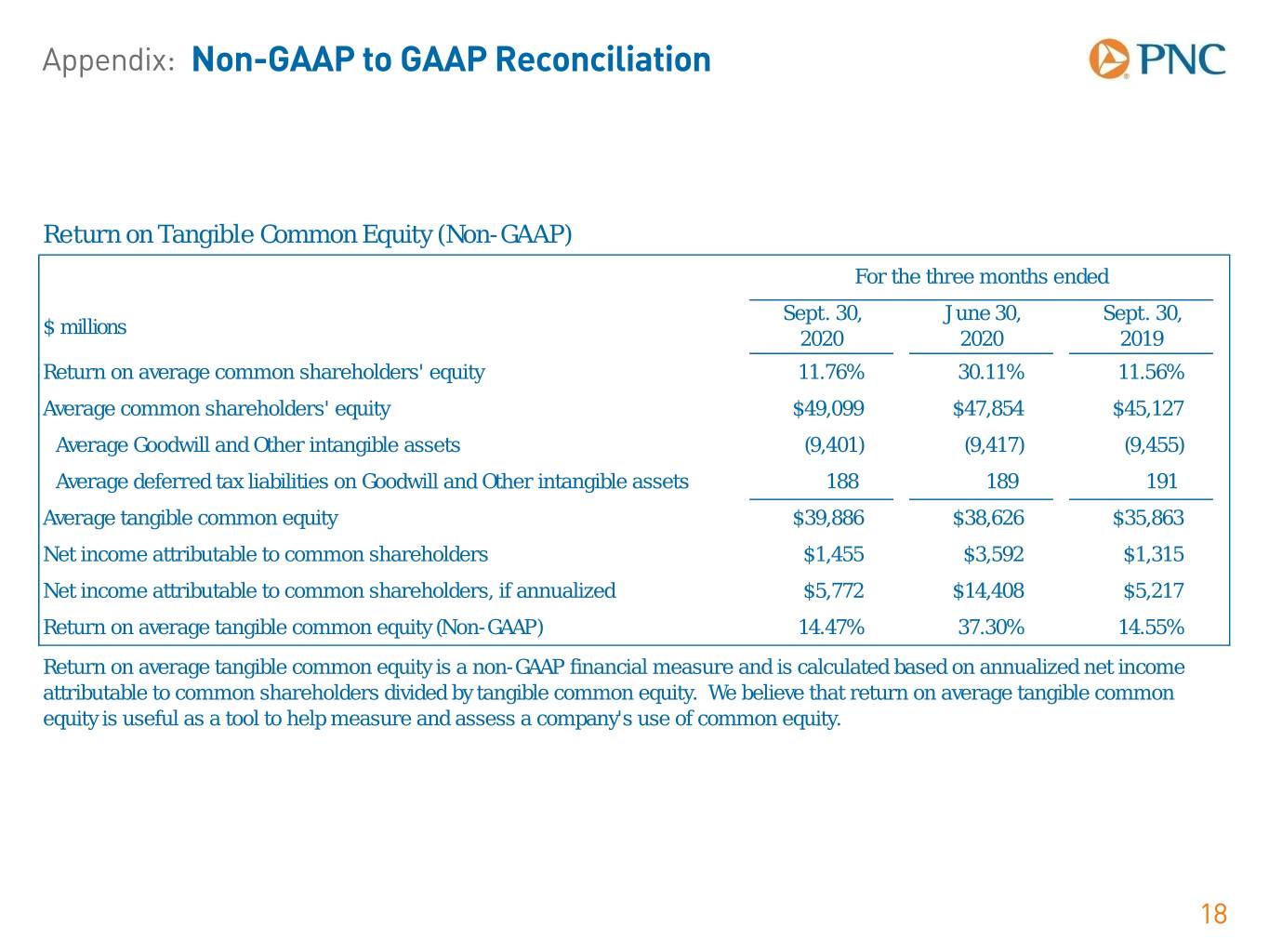
Appendix: Non-GAAP to GAAP Reconciliation Return on Tangible Common Equity (Non- GAAP) For the three months ended Sept. 30, June 30, Sept. 30, $ millions 2020 2020 2019 Return on average common shareholders' equity 11.76% 30.11% 11.56% Average common shareholders' equity $49,099 $47,854 $45,127 Average Goodwill and Other intangible assets (9,401) (9,417) (9,455) Average deferred tax liabilities on Goodwill and Other intangible assets 188 189 191 Average tangible common equity $39,886 $38,626 $35,863 Net income attributable to common shareholders $1,455 $3,592 $1,315 Net income attributable to common shareholders, if annualized $5,772 $14,408 $5,217 Return on average tangible common equity (Non-GAAP) 14.47% 37.30% 14.55% Return on average tangible common equity is a non-GAAP financial measure and is calculated based on annualized net income attributable to common shareholders divided by tangible common equity. We believe that return on average tangible common equity is useful as a tool to help measure and assess a company's use of common equity. 18
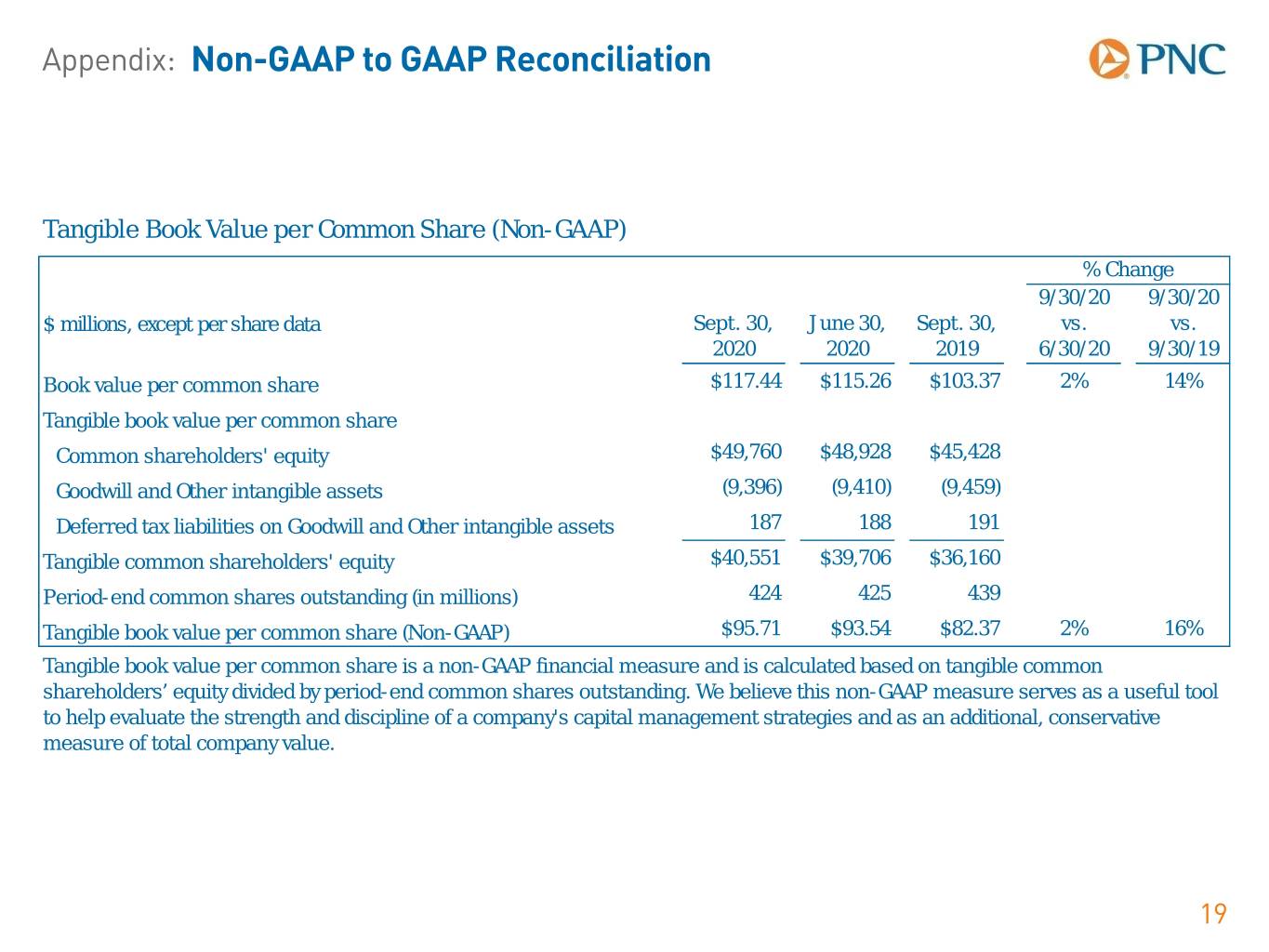
Appendix: Non-GAAP to GAAP Reconciliation Tangible Book Value per Common Share (Non- GAAP) % Change 9/ 30/ 20 9/ 30/ 20 $ millions, except per share data Sept. 30, June 30, Sept. 30, vs. vs. 2020 2020 2019 6/ 30/ 20 9/ 30/ 19 Book value per common share $117.44 $115.26 $103.37 2% 14% Tangible book value per common share Common shareholders' equity $49,760 $48,928 $45,428 Goodwill and Other intangible assets (9,396) (9,410) (9,459) Deferred tax liabilities on Goodwill and Other intangible assets 187 188 191 Tangible common shareholders' equity $40,551 $39,706 $36,160 Period-end common shares outstanding (in millions) 424 425 439 Tangible book value per common share (Non-GAAP) $95.71 $93.54 $82.37 2% 16% Tangible book value per common share is a non-GAAP financial measure and is calculated based on tangible common shareholders’ equity divided by period-end common shares outstanding. We believe this non-GAAP measure serves as a useful tool to help evaluate the strength and discipline of a company's capital management strategies and as an additional, conservative measure of total company value. 19
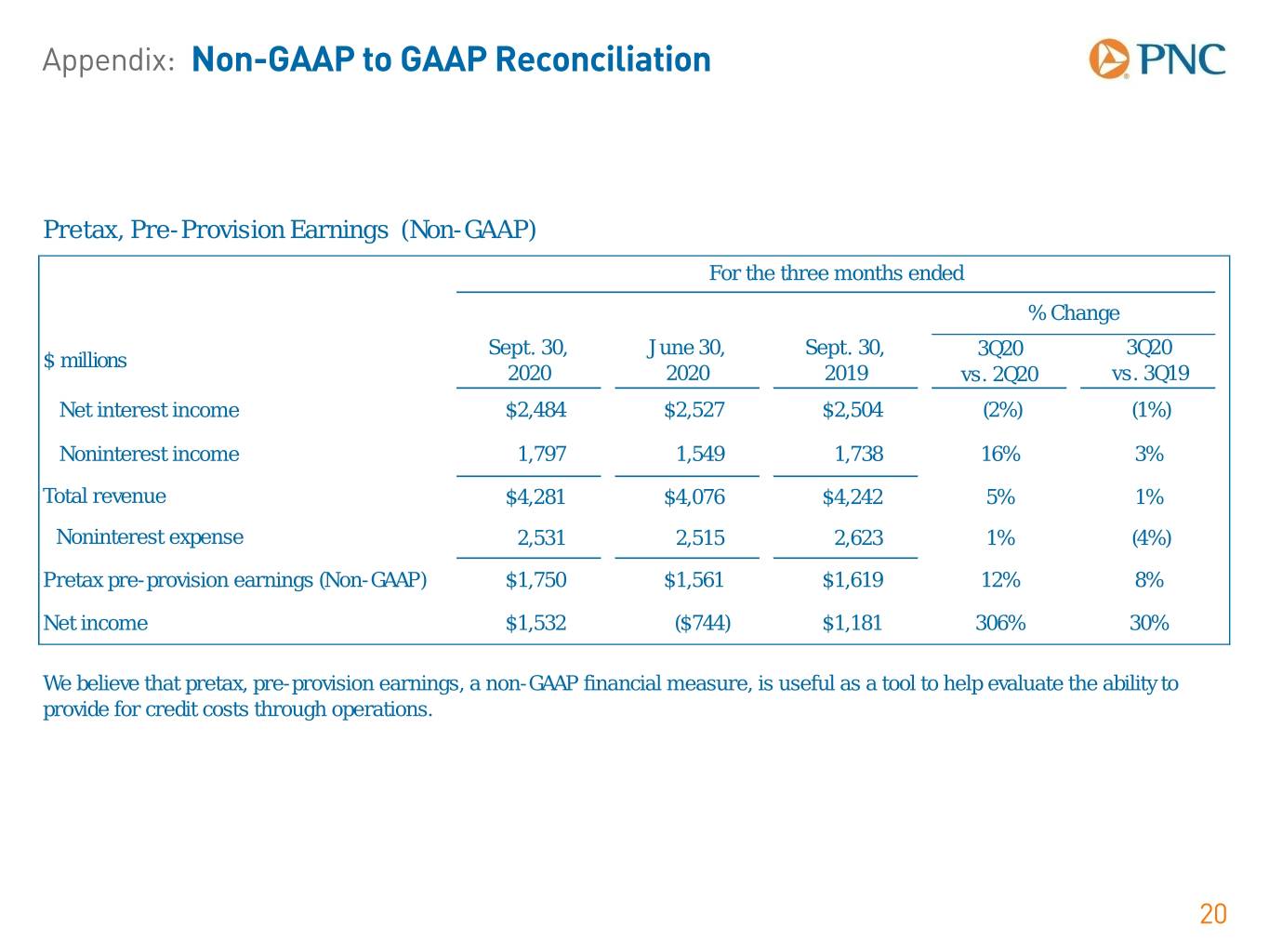
Appendix: Non-GAAP to GAAP Reconciliation Pretax, Pre- Provision Earnings (Non- GAAP) For the three months ended % Change Sept. 30, June 30, Sept. 30, 3Q20 3Q20 $ millions 2020 2020 2019 vs. 2Q20 vs. 3Q19 Net interest income $2,484 $2,527 $2,504 (2%) (1%) Noninterest income 1,797 1,549 1,738 16% 3% Total revenue $4,281 $4,076 $4,242 5% 1% Noninterest expense 2,531 2,515 2,623 1% (4%) Pretax pre-provision earnings (Non-GAAP) $1,750 $1,561 $1,619 12% 8% Net income $1,532 ($744) $1,181 306% 30% We believe that pretax, pre-provision earnings, a non-GAAP financial measure, is useful as a tool to help evaluate the ability to provide for credit costs through operations. 20
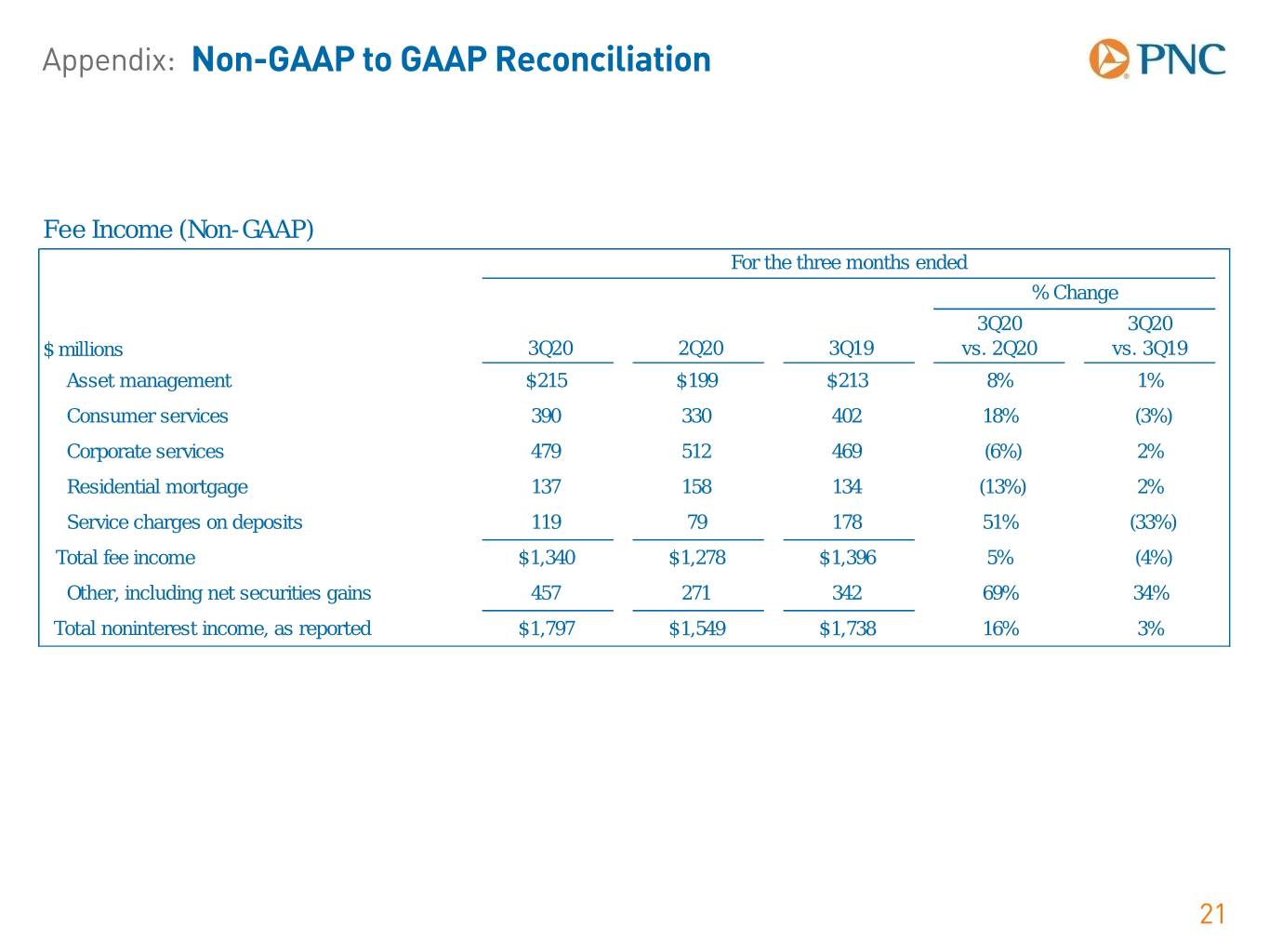
Appendix: Non-GAAP to GAAP Reconciliation Fee Income (Non-GAAP) For the three months ended % Change 3Q20 3Q20 $ millions 3Q20 2Q20 3Q19 vs. 2Q20 vs. 3Q19 Asset management $215 $199 $213 8% 1% Consumer services 390 330 402 18% (3%) Corporate services 479 512 469 (6%) 2% Residential mortgage 137 158 134 (13%) 2% Service charges on deposits 119 79 178 51% (33%) Total fee income $1,340 $1,278 $1,396 5% (4%) Other, including net securities gains 457 271 342 69% 34% Total noninterest income, as reported $1,797 $1,549 $1,738 16% 3% 21